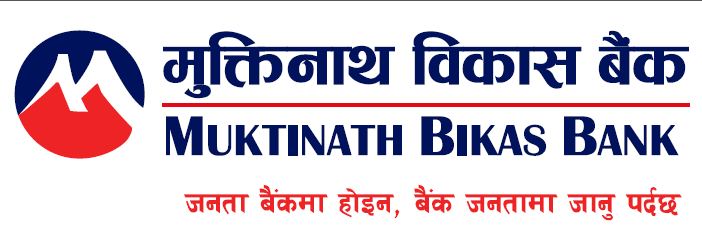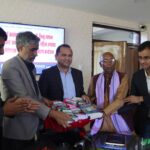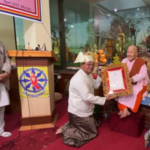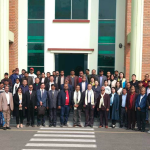
By Razen Manandhar
After years of uncertainty and political wrangling, the Melamchi Water Supply Project (MWSP) is picking up some pace. This has brought a sense of relief for residents of Kathmandu Valley, the capital of Nepal.
Asian Development Bank (ADB) has agreed to new terms and sanctioned a US$137 million loan for the Melamchi project according to a press release issued on February 8, 2008. Other donors are the Japan Bank for International Cooperation, the Japan International Cooperation Agency, the Nordic Development Fund and the Organization of Petroleum Exporting Countries Fund for International Development. The Government of Nepal is contributing US$90.6 million.
Most of Kathmandu’ s1.8 million residents currently receive piped water for only a couple of hours a day. Many people rely on alternative water sources such as shallow wells, public taps, rainwater, tankers, or bottled water — which are expensive.
The future of the Melamchi project hung in the balance for a long time. ADB’s premise was that the government of Nepal should first hand over the distribution of water to a private operator to sanction the loan. And, after a long discussion at political level on whether to accept a foreign operator or not, the government formed a semi-private body named Kathmandu Valley Water Supply Management Board (KVWSMB) with representatives from local municipalities and chambers of commerce. It first took over the assets and liabilities, formerly possessed by the state-owned Nepal Water Supply Corporation (NWSC) and leased it to a private company named Kathmandu Upatyaka Khanepani Limited (KUKL) for 30 years on February 1, 2008. The Ministry for Physical Planning and Works is the Executing Agency for the Melamchi Water Supply Project while Melamchi Water Supply Development Board (MWSDB) is the Implementing Agency.


Meantime, the project cost has also been recalculated from US$ 464 million to US$ 317.3 million, probably to make people less opposed to the project.
“The project now stands on a historic crossroad, after a long story of failure, confusion and complexity. I believe that it would gather speed from now onwards because we have clearly seen that the donors are ready to contribute,” said Hisila Yami, the Minister for Physical Planning and Works.
The hard-line Maoist minister surprised politicians and bureaucrats by convincing the ADB and other international donors to fund the water project on her conditions. “We made a new record by accepting the foreign donors for our water project. It is indeed the need of the time,” she proclaimed.
Thus the water from Melamchi, 26 km away from the capital, will be supplied to the people, who have depended on unreliable supplies for a long time. Some 100,000 connections to the state-managed water distribution network have proved to be grossly inadequate with the population growing at the whopping rate of over 10 percent per year in the city.
History of delays
Water supply was sufficient in the traditional settlements of Kathmandu Valley, thanks to the old water fountains which provided locals with a continuous water supply from the mountains. Later, after the 1950s, as the population of the capital grew, the traditional sources proved to be increasingly inadequate.
Most of the large urban areas including Kathmandu city and towns such as Lalitpur, Bhaktapur, Kirtipur and Madhyapur get their water sup plies from NWSC. This corporation comes under the Ministry of Physical Planning and Works.

In the 1990s, following the establishment of multi-party democracy in Nepal, the government entered into discussions with the World Bank to finance the institutional reform of the water sector. The Kathmandu Water Supply Project was envisioned which would allocate funds for rehabilitation of the urban networks and involve the private sector in the form of a management or a lease contract. Various options for private sector participation (PSP) in the provision of water services in the urban areas of Kathmandu Valley were examined by the World Bank.
However, the World Bank’s efforts ended in naught because not many reputed firms were willing to take up the risk of operating water services in Kathmandu Valley. In 2001, the World Bank retreated. In 2003, ADB stepped in to take the PSP idea further by proposing a performance-based management contract.
In the context of the Melamchi project, ADB also supported a project to reform water service institutions. The bank proposed the setting up of a water authority that would act as the asset owner of the systems. The authority would then be responsible for developing additional infrastructure for water and wastewater systems required in the future.
It would also award and monitor a license for the operation and management of the water supply and wastewater systems serving Kathmandu Valley.
After many delays, the project went to the tendering stage but only one company, Severn Trent submitted a bid at closing time in 2005. Meanwhile, anti-privatisation campaigners began to pressurise Severn Trent to withdraw from the country. The Melamchi project became the subject of intense media attention. Nepali activists were joined by international NGOs and in 2007, Severn Trent retreated from the project.
ADB officially informed the Nepal Minister for Physical Planning and Works that overturning the cabinet decision of the previous government to award the contract to British firm Severn Trent Water International would not only hinder the implementation of the Melamchi project, but also affect Nepal’s status as Developing Member Country (DMC) of the bank.

Thanks to political instability, petty interests of politicians and demanding locals, the Melamchi project remained a challenge to all those who advocated multinational cooperation and international funding for mega water projects. Problems with contractors and builders, a change in the project office, allegations of corruption and occasional strikes of the locals or government staffers- all contributed to turning the much-hyped project into a non-starter.
However, the year 2008 has brought positive developments. Deputy Executive Director of the MWSP, Purna Das Shrestha says that the renewal of the loan agreement has re-energised the project and bids have been invited for construction of the 26-km tunnel.
“The construction of the tunnel would make people believe that the water will eventually come to the capital. We know that we are late, but we have not yet given up. Rather, we are more committed to complete it amidst local problems,” he said.
It is expected that the tunnel construction will begin by January 2009 and the whole project will be completed by 2013, if the things move smoothly.
Neglect of local concerns
One of the lessons learned from the Melamchi project is that disregarding local voices can become a serious impediment to a project. According to the locals of the Melamchi Valley, the project has been totally neglecting the local demands. The officers at the Site Office of MWSP were seldom found communicating with the locals. Rather, they were inclined to use power, money or even Maoist rebels to control them. The situation was destined for a conflict.
Ram Bahadur Khadka, a local leader, says that the project officers never treated them amicably and only produced thick reports which are often far from reality. “We never opposed the project. But the project officers neglected our demands and suggestions,” he says.

The demands of the local stakeholders seem to be basic and have even been promised in project documents. The main demand is for compensation for the 14 villages affected by the project. The locals also want the government to promise that there will be an access road from the village to the highway, water for irrigation, alternative occupation for fishermen’s community, some schools and health posts and so on.
Joint-secretary Suman Prasad Sharma, who now heads the KVWSMB after working for years in the Melamchi project, admits that coordination between the locals and the project authorities is lacking. “We wish a better relationship could be maintained, but it is very difficult,” he said.
He also says that the delay in the project due to various problems including a lack of clear scope of work. “The project is of a complex nature and since we have to depend on strategies of the donors, delays at various stages is evident. One delay causes another delay and it keeps mounting,” he said.
In its 2003 report, the ADB itself says “The Project would have benefited from a more proactive public consultation programme that addressed issues such as tariffs and private sector participation, rather than just concentrating on the environmental aspects. The project was a good example of the need for early NGO involvement, and to address issues in a participatory manner”.
The report also says that land acquisition was more complex than originally envisaged.
“The lesson for future projects: examine land acquisition issues more closely before project appraisal,” it says.
How much will the water cost?
Water is coming from Melamchi, but consumers are still in confusion about how much it will cost. Since it is a loan-based project, consumers will have to pay it back in one way or another. The costlier the project becomes, the more money the consumers will have to pay for the water.
According to a recent ADB report, the Nepal government has given an assurance that the average tariff per cubic metre of water sales will be increased to meet certain agreed cost recovery levels. The government has assured that by June 2013, when water is expected to start flowing from the Melamchi tunnel, the average tariff charged by KUKL will not be less than the level required to cover:
i) KUKL’ s operating costs,
ii) Payments by KUKL to the Water Supply Tariff Fixation Commission (WSTFC) and KVWSMB,
iii) debt service and
iv) a margin sufficient to finance some investments in the distribution network from its own resources before full cost recovery principles apply.
Re-allocating funds
Due to the withdrawal by three co-financing development partners — The World Bank, NORAD and SIDA representing 28.7% of the original total project cost of US$464 million, there is a need to allocate the remaining available funds by careful prioritisation.

The single largest infrastructure component of the Melamchi project is the 26-km Melamchi diversion tunnel. Originally, this was to be financed partially by the agencies NORAD and SIDA, which later withdrew from the project. The total base cost for the tunnel which was originally estimated at US$74.3 million is now re-estimated at US $65.2 million. The current donors have proposed that the Bulk Distribution System (BDS) and Distribution Network Improvement (DNI) components be implemented such that the priority zones, where water shortages are the highest are benefited first.
Management overhaul needed
Apart from the much publicised political and social instability in Nepal, which led to the withdrawal of funding and a subsequent stalling of the Melamchi project, there are some compelling flaws in the management processes within MWSP that have come under scrutiny.
A recent ADB report says that the Project Management Unit (PMU) has been filled with water engineers assigned by the Ministry of Physical Planning and Works, rather than with qualified and experienced individuals. These engineers are subservient to the Ministry rather than the Melamchi Water Supply Development Board (MWSDB), the implementing agency. The senior management of PMU faced problems in enforcing discipline and professionalism since they had little control over staff selection or dismissal. Also, since the Melamchi Project does not merely involve technical engineering aspects but includes complex institutional, environmental and social components, the workforce lacked the training to handle these aspects.
ADB recommends that the management structure of MWSP should be changed in order to avoid further problems. The MWSDB should be reorganized to achieve strong and professional management. According to ADB, the MWSDB should consider employing contractual staff on a performance basis with competitive salaries who would be accountable to MWSDB. This would reduce the requirement for costly long-term consultants.
Keeping the PMU lean and efficient is also a recommendation made by ADB, in order that it concentrates on management and administration rather than implementation. The implementation of project components could be outsourced to third party consultants, community-based organisations and contractors. Supervision of implementation could also be outsourced to consultants.
“The PMU’s role should return more strictly to day-to-day planning, coordination, fiscal and organizational management, and progress and compliance monitoring and reporting,” says the ADB report.
How about including hydropower and irrigation?
Recently, a group of economists, environmentalists, and other experts have come up with a new idea to include hydropower and irrigation in the MWSP. In its current form, the MWSP benefits only the capital, Kathmandu whereas the multi-purpose project would help a larger population. They believe that it can generate 225 MW of electricity and the same water could be used for irrigating more than 30,000 hectares downstream if three other rivers Yangri, Larke and Balephi are also included in the same tunnel.
This plan faces the criticism that the Melamchi project would only suffer yet another delay. However, the experts suggesting the multipurpose scheme point out that the construction of the tunnel has not begun yet and incorporating the hydropower generation aspects into the design would only take a few extra months. The diameter of the tunnel would need to be increased from 3.7 to 5m, but the cost of construction per metre of the tunnel would not go up significantly up to a maximum diameter of 5.6m according to them. Also, the hydropower generation component could come later and would not interfere with the water supply component.
The Ministry, however, has not shown any interest in the scheme publicly.
Why are low-cost solutions being ignored?
When the whole country, including international institutions, are concentrating on the multi-million dollar Melamchi project, not much attention is being paid to alternatives, which may provide immediate relief to the locals with minimum cost. Experts say the supply of water would automatically be increased if the non-revenue water which stands at 40% is controlled. In addition, supplies from the nearby Kokdu River, utilisation of traditional water fountains as well as rainwater harvesting could provide low-cost solutions.
Some progress despite hindrances
Despite the history, if delays, ADB’s recent re-newing of its loan agreement has made the government officials and people more hopeful about the project’s completion. Substantial progress has been achieved in bringing about institutional reforms, though slowly.
The reforms include separation of ownership of assets from their management, the establishment of an independent regulatory commission for regulating water tariffs and the establishment of an autonomous water operator company. According to ADB, this level of institutional reform has no precedent in the South Asian region.
The government has passed three acts — Water Supply Management Board Act, Nepal Water Supply Corporation Act, and Water Tariff Regulation Commission Act. The formation of KUKL and handing over of NWSC sections to is an achievement in itself. In addition, the staffers of state-owned NWSC, after protesting against “privatisation” are finally convinced that reform of the corporation is necessary and what is being done is not actually privatisation.
It is time for all the stakeholders of the Melamchi Project to ensure that there are no more unnecessary delays. It is estimated that the Kathmandu Valley needs at least 147 MLD of water today and about 268 MLD by the year 2016. This might be the last chance to bring water to the thirsty valley. AW
Melamchi Water Supply Project in a nutshell
The Melamchi Water Supply Project (MWSP) is an inter-basin water supply project which supplies water from snow-fed Melamchi river in the Kosi basin in Sindhupalchowk district to the Kathmandu valley which is in the Bagmati basin in Kathmandu/ Lalitpur/ Bhaktapur districts. The project is financed by a number of international banks and the total cost is estimated at about half a billion US dollars.
The project is designed to solve the chronic water supply shortage in the Kathmandu Valley with the diversion of 170 MLD water from the Melamchi River through a 26km long tunnel. The project comprises of the following parts:
A. Infrastructure Development
i) Melamchi Diversion Scheme (MDS):
Diversion weir, desilting basin, 26 km tunnel, 25 km adit access road, 18 km main access road, and upgrading of 22 km approach road
ii) Water Treatment Plant : 170 MLD plant at Mahankal in Sundarijal of Kathmandu
iii) Bulk Distribution System: 54 km of bulk transmission mains (300 to 1,400 mm diameter) and ten storage reservoirs around the Kathmandu Valley with total capacity of 72,000m3.
iv) Distribution Network Improvement: Recruitment of a Private Operator for water supply management and rehabilitation and extension of existing facilities.
v) Wastewater System Improvement:
Includes rehabilitation of the existing sewer networks and treatment plants.
B. Social and Environmental Support
i) Social Uplift Program
ii)Resettlement Action Plan: Implementation of land acquisition along the Main Access Road, Adit Access Road, reservoir and pipeline routes for the Bulk Distribution System and water treatment plant in Sundarijal.
ii) Hygiene and education program in Kathmandu Valley and a public awareness program in the Project area.
iv) Groundwater monitoring program, and
v) Environmental Management Plan.
C. Institutional Reforms
i) Establishment of the National Water Supply Regulatory Board
ii) Establishment of the Kathmandu Valley Water Authority
iii) Groundwater licensing in Kathmandu Valley
iv) Promulgation of the Groundwater Resources Management Act
v) Private Sector Management of Urban Water Supply
vi) Project Implementation Support
vii) Establishment of the Project Management Unit
viii) Recruitment of Panels of Experts: Technical, Social and Environmental
(This article was published in Singapore based magazine “Asian Water” (20080312)





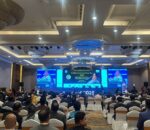 काठमाडौंमा ‘बौद्ध अन्तर्राष्ट्रिय ट्राभल मार्ट २०२५’ सुरु
काठमाडौंमा ‘बौद्ध अन्तर्राष्ट्रिय ट्राभल मार्ट २०२५’ सुरु “शंखरापुर”वृत्तचित्रको वल्र्डवाइड प्रिमियर
“शंखरापुर”वृत्तचित्रको वल्र्डवाइड प्रिमियर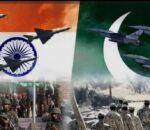 भारतको पाकिस्तानमाथि मिसाइल प्रहारपछिको संभावित प्रभाव
भारतको पाकिस्तानमाथि मिसाइल प्रहारपछिको संभावित प्रभाव Lumbini to Host the 4th Asian Buddhist Cultural Festival 2025: A Global Celebration of Peace and Heritage
Lumbini to Host the 4th Asian Buddhist Cultural Festival 2025: A Global Celebration of Peace and Heritage